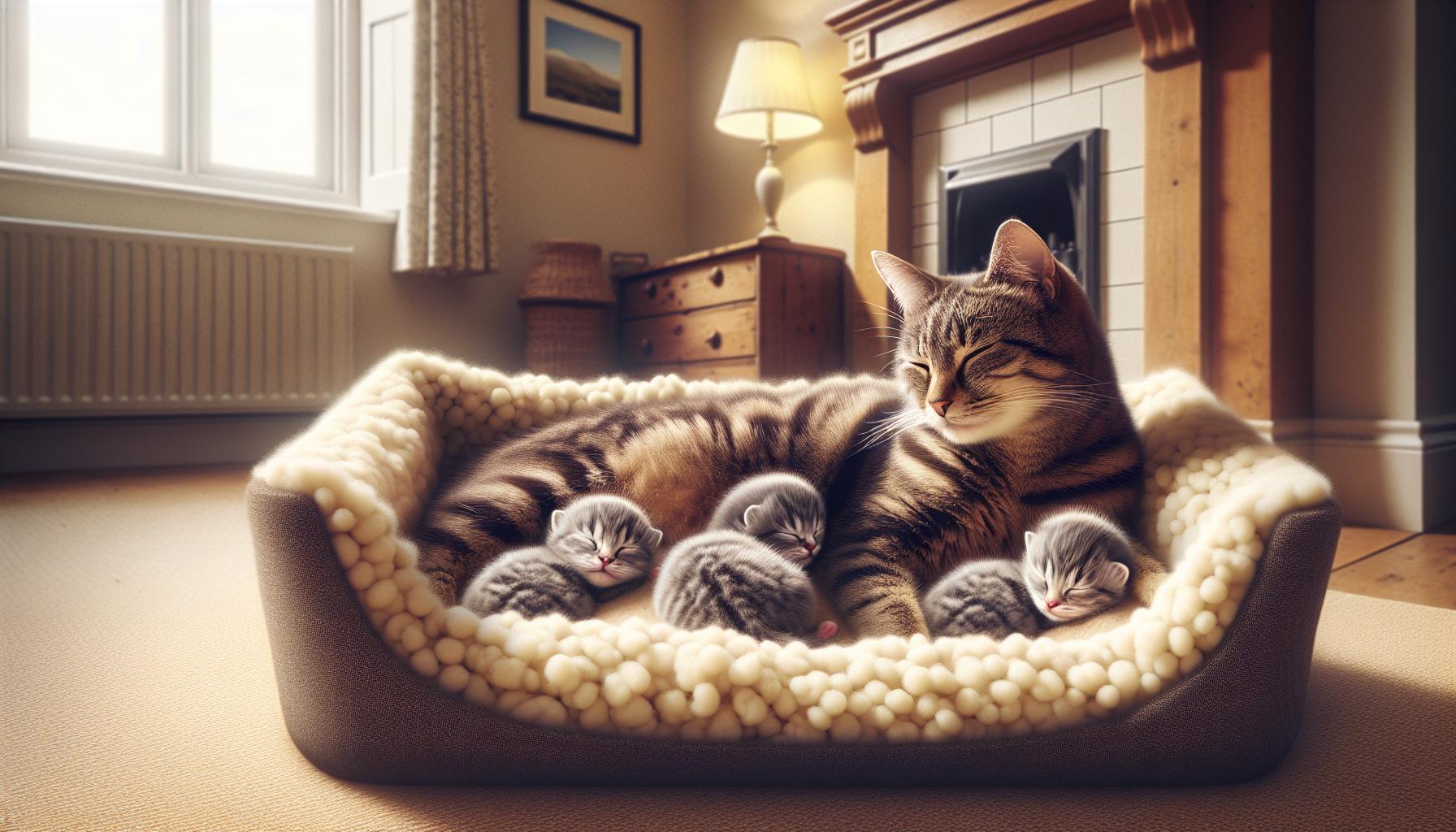Welcoming newborn kittens and their mother into your home is both exciting and rewarding. Caring for them properly ensures their health and happiness from day one. It’s essential to understand the unique needs of both the mother cat and her kittens to provide the best possible environment.
Creating a safe, comfortable space and addressing the nutritional requirements are just the beginning. With the right guidance, you’ll support the mother in her nurturing role while fostering a thriving start for the kittens. This article offers practical tips and expert insights to help you navigate the early stages of kitten and mother cat care with ease.
Understanding the Mother Cat’s Role
The mother cat ensures her kittens’ survival through several key responsibilities. She provides essential nutrition by nursing, delivering antibodies that bolster the kittens’ immune systems. Grooming maintains cleanliness, preventing infections and stimulating circulation. The mother establishes a safe environment, shielding her kittens from threats and stressors. She teaches vital behaviors, such as hunting and social interaction, essential for their development. Monitoring each kitten’s health, she identifies any issues early, facilitating prompt care. Additionally, the mother cat regulates the litter’s temperature through body heat, ensuring optimal growth conditions. Understanding these roles highlights the importance of supporting the mother cat to promote the well-being of her kittens.
Key Responsibilities
- Nursing: Supplies vital nutrients and antibodies.
- Grooming: Maintains hygiene and stimulates circulation.
- Protection: Shields kittens from threats and stress.
- Education: Teaches hunting and social behaviors.
- Health Monitoring: Identifies and addresses health issues.
- Temperature Regulation: Keeps the litter warm for optimal growth.
Supporting the Mother Cat
Providing a nutritious diet and a stress-free environment supports the mother cat in fulfilling her roles effectively. Ensuring she has access to clean water, high-quality kitten food, and a quiet space promotes her health and, in turn, the health of her kittens. Regular veterinary check-ups help maintain her well-being, allowing her to care for her litter without complications.
- Active Nursing: Kittens actively suckling.
- Regular Grooming: Consistent cleaning of herself and her kittens.
- Alert Behavior: Responsive to environmental changes.
- Consistent Eating: Maintaining a healthy appetite.
- Active Play: Engaging with kittens through play and interaction.
Maintaining the mother cat’s health and well-being directly influences the growth and development of her kittens, ensuring a strong foundation for their future.
Preparing a Safe and Comfortable Environment

Creating an optimal environment is crucial for the health of both the mother cat and her newborn kittens. Proper preparation ensures their safety and promotes healthy development.
Setting Up a Whelping Box
A well-prepared whelping box offers security and warmth. Use a spacious container, approximately 24 inches long, with low sides for easy access. Line the box with soft, washable bedding such as fleece or blankets, changing it daily to maintain cleanliness. Position the box in a quiet, draft-free area away from household traffic to reduce stress for the mother and her kittens.
Maintaining Proper Temperature
Temperature regulation is vital for newborn kittens’ survival. Maintain the whelping area between 85°F and 90°F for the first week. Use a heating pad set to low under half of the bedding to allow kittens to move away if they become too warm. Gradually decrease the temperature by 5°F each week until the kittens can comfortably regulate their body heat. Monitor the environment with a reliable thermometer to ensure consistent warmth.
Feeding and Nutrition
Proper feeding and nutrition ensure the health and growth of both the mother cat and her newborn kittens. Adequate nutrition supports vital functions and development during this critical period.
Diet for the Mother Cat
A balanced diet provides the necessary nutrients for lactation and recovery post-birth. High-quality commercial kitten food meets increased energy and protein needs. Ensure access to fresh water at all times to maintain hydration. Incorporate wet food to enhance moisture intake, supporting milk production. Supplements are generally unnecessary if feeding a complete diet, but consult a veterinarian for specific recommendations.
Feeding Newborn Kittens
Newborn kittens rely exclusively on their mother’s milk for the first four weeks. Monitor nursing sessions to ensure each kitten feeds adequately. If the mother is unavailable, use a kitten milk replacer formulated to match the nutritional profile of cat milk. Feed kittens every two to three hours, including nighttime, to maintain energy levels. Gradually introduce wet kitten food at four weeks, mixing it with milk replacer to create a smooth consistency. Transition to solid food by eight weeks, ensuring kittens receive a diet specifically designed for their growth stage.
Health Care and Hygiene
Maintaining optimal health and hygiene ensures the well-being of both the mother cat and her newborn kittens. Implementing regular care routines prevents illnesses and promotes a clean environment.
Routine Cleaning
- Whelping Box Maintenance
Change bedding daily to keep the area dry and sanitary. Use washable, soft materials to prevent irritation.
- Litter Box Management
Clean the litter box at least twice daily. Choose unscented, clumping litter to avoid respiratory issues.
- Disinfection Practices
Wipe surfaces with pet-safe disinfectants weekly. Ensure all cleaning products are non-toxic to cats.
- Grooming Schedule
Brush the mother cat weekly to remove loose hairs and reduce shedding. Trim kittens’ nails once they open their eyes.
- Ventilation Control
Maintain proper airflow in the living area to prevent mold and mildew. Use air purifiers if necessary.
- Respiratory Infections
Monitor for sneezing, coughing, or nasal discharge. Seek veterinary care if symptoms persist.
- Diarrhea and Dehydration
Check kittens for loose stools and reduced moisture intake. Ensure access to kitten milk replacer and consult a vet if needed.
- Skin Parasites
Look for excessive scratching, hair loss, or visible fleas. Use appropriate treatments recommended by a veterinarian.
- Nutritional Deficiencies
Assess the mother’s diet for adequate nutrients. Provide high-quality kitten food to support growth and milk production.
- Temperature Regulation Issues
Ensure the whelping area stays between 85°F and 90°F initially. Adjust gradually to help kittens acclimate to ambient temperatures.
- Injuries and Physical Abnormalities
Examine kittens for any signs of injury or congenital defects. Immediate veterinary attention may be required for serious conditions.
Maintaining vigilance and adhering to hygiene practices fosters a healthy environment for the mother cat and her kittens.
Socialization and Handling
Early socialization fosters well-adjusted kittens and maintains the mother’s comfort.
Handling Kittens
Gentle handling promotes trust and confidence in kittens.
- Frequent Interaction: Handle kittens several times daily to familiarize them with human contact.
- Gentle Touch: Use soft strokes to avoid causing stress or injury.
- Short Sessions: Keep handling sessions brief, especially during the first few weeks.
- Age-Appropriate Handling: Increase interaction time as kittens grow older and more resilient.
Interacting with the Mother Cat
Respecting the mother cat’s space ensures her well-being and supports kitten development.
- Minimal Disturbance: Limit interactions to essential care to prevent stress.
- Positive Reinforcement: Reward the mother with treats to associate handling with positive experiences.
- Monitor Behavior: Observe the mother’s reactions to interactions and adjust accordingly.
- Gradual Introduction: Slowly introduce new stimuli to the mother to enhance her adaptability.
Socialization Environment
Creating a stimulating environment aids in the kittens’ social development.
- Safe Spaces: Provide areas where kittens can explore without threats.
- Variety of Textures: Introduce different surfaces to develop tactile awareness.
- Interactive Toys: Use toys that encourage play and physical activity.
- Exposure to Sounds: Gradually expose kittens to various sounds to build resilience.
Health and Safety
Ensuring health and safety during socialization prevents accidents and illnesses.
- Regular Health Checks: Monitor kittens and the mother for signs of illness.
- Clean Environment: Maintain hygiene to reduce the risk of infections.
- Supervised Play: Always supervise interactions to prevent injuries.
- Safe Handling Practices: Educate handlers on proper techniques to handle kittens and the mother safely.
Consistency and Routine
Maintaining a consistent routine supports emotional stability for both kittens and the mother.
- Scheduled Interactions: Establish regular times for handling and socialization activities.
- Predictable Environment: Keep the living area stable to minimize anxiety.
- Routine Care: Perform feeding and cleaning consistently to reinforce security.
By implementing structured socialization and handling practices, caregivers can ensure the healthy development of kittens and the well-being of the mother cat.
Conclusion
Providing a safe and nurturing environment sets the foundation for healthy kittens and a happy mother cat. Ensuring proper nutrition supports their growth and well-being. Regular monitoring and gentle handling foster trust and confidence in the kittens while keeping the mother comfortable. Maintaining cleanliness and a stress-free space promotes overall health for the entire family. By paying attention to their unique needs and creating a supportive home, caregivers can enjoy the rewarding experience of watching the kittens thrive and the mother cat flourish.

